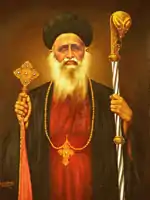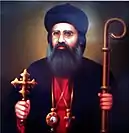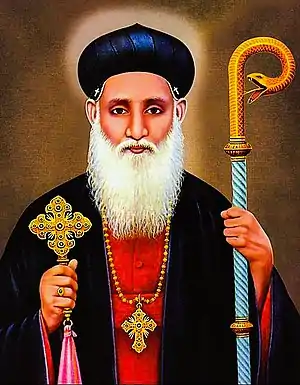Jacobite Syrian Christian Church
The Jacobite Syrian Christian Church (JSCC),[5][6][7][8] also known as the Malankara Jacobite Syrian Orthodox Church,[9][10][11][12][13] the Jacobite Syrian Church,[14] or the Syriac Orthodox Church in India,[15][16][17] is an autonomous Oriental Orthodox church based in the Indian state of Kerala, and is an integral branch of the Syriac Orthodox Church of Antioch. It recognizes the Syriac Orthodox Patriarch of Antioch and All the East as Supreme Head of the church. It functions as a largely autonomous unit within the church, under the authority of the Catholicos of India, Thomas I. Currently, this is the only church in Malankara which has a direct relationship with the Syriac Christians of Antioch, which has continued from after the schism and it continues to employ the West Syriac Rite Liturgy of Saint James.[18][19][20]
 Jacobite Syrian Christian Church | |
|---|---|
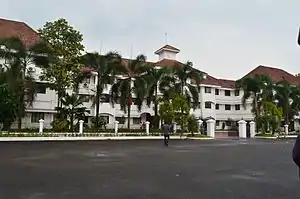 Puthencruz Patriarchal Centre in Kochi, India | |
| Abbreviation | JSCC |
| Classification | Oriental Orthodoxy |
| Orientation | Eastern Christianity |
| Scripture | Peshitta, Vishudhagrandham (Malayalam Translation) |
| Theology | Miaphysitism |
| Polity | Episcopal polity |
| Apostolic See | Holy Apostolic See of Antioch and All East[1] |
| Supreme Patron | Ignatius Aphrem II Patriarch of Antioch |
| Catholicos | Baselios Thomas I Catholicos |
| Affiliation | Syriac Orthodox Church of Antioch |
| Region | India and Nasarani Malayali Diaspora |
| Language | Malayalam, English, Hindi, Syriac, Tamil, Kannada |
| Liturgy | West Syriac Rite- Divine Liturgy of Saint James |
| Headquarters | Patriarchal Center, Puthencruz, Kochi, India |
| Origin | Apostolic Age In India AD 345,[2][3] AD 1665 |
| Separated from | Saint Thomas Christians |
| Branched from | Syrian Orthodox Church |
| Members | 1.2 million[4] |
| Other name(s) | Malankara Jacobite Syrian Orthodox Church Syriac Orthodox church |
| Official News Portal | J.S.C NEWS |
| Part of a series on |
| Christianity in India |
|---|
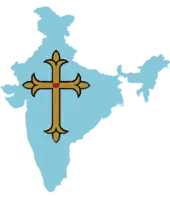 |
| Part of a series on |
| Oriental Orthodoxy |
|---|
 |
| Oriental Orthodox churches |
|
|
Name
The Emperor Justin I supported the Chalcedonians, The non-Chalcedonian Severus Patriarch of Antioch exiled in Egypt and died on 538. At the situation of church remaining only three bishops, At that time Jacob Baradeus restoring the church by the help of Queen Theodra. The non-Chalcedonian church, that would later become the Syriac Orthodox Church of Antioch also known as Jacobite Syrian Christians. The Syrian Orthodox church of India adopted the Title as the respect of Jacob Baradeus.[21]
Headquarters
Puthencruz is the headquarters of the Jacobite Syrian Christian Church in India Registered as a Society under Societies act of the Government of India. Its headquarters is named after the illustrious Patriarch of Antioch Ignatius Zakka I Iwas. The property was bought and built under the leadership of the Catholicos of India Baselios Thomas I, after the church faced difficulties in continuing its functioning from its base at Muvattupuzha with the demise of Catholicos Baselios Paulose II.
- St. Athanasius Catholicate Cathedral, Puthencuriz[22]
- JSC Publications, The official publishing house of the church are also a part of the large complex.
- Malankara Jacobite Syrian Sunday School Association (MJSSA) is also based in Puthencruz.[23]
- St.Thomas College Arts and Science is also run in the premises of the Zakka centre.[24]
- Michael Dionysius(M.D) Book Stall, official book house of Jacobite Syrian Christian Church.[25]
- This is the place where Universal Malankara Convention, the official gospel convention of the community, that is generally conducted from 26 to 31 December of every year.
History
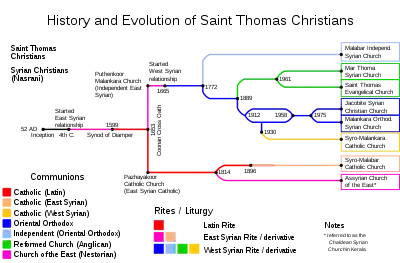
It is believed that Saint Thomas Christians of Malabar were in communion with the Church of the East from 295 to 1599.[26] They received episcopal support from Syriac bishops, who traveled to Kerala in merchant ships along the spice route, while the local leader of the Saint Thomas Christians held the rank of Archdeacon; it was a hereditary office held by the Pakalomattam family. In the 16th century, the overtures of the Portuguese padroado to bring the Saint Thomas Christians into Latin Rite Catholicism led to the first of several rifts in the community due to Portuguese colonialists, and the establishment of the Syro-Malabar Church and the Malankara Church factions. Since then, further splits have occurred, and the Saint Thomas Christians are now divided into several factions.
Saint Thomas Christians were administratively under the single native dynastic leadership of an Archdeacon (a native ecclesiastical head with spiritual and temporal powers, deriving from Greek term arkhidiākonos) and were in communion with the Church of the East, centered in Persia, from at least 496.[27][28] The indigenous Church of Malabar/Malankara followed the faith and traditions handed over by the Apostle St. Thomas. During the 16th century, the Portuguese Jesuits began deliberate attempts to annex the native Christians to the Catholic Church, and in 1599 they succeeded through the Synod of Diamper. Resentment against these forceful measures led the majority of the community under the Archdeacon Thomas to swear an oath never to submit to the Portuguese, known as the Coonan Cross Oath, in 1653. The Malankara Church consolidated under Thoma I welcomed Gregorios Abdal Jaleel, who regularized the canonical ordination of Thoma as a bishop.
Meanwhile, the Dutch East India Company defeated the Portuguese and gained supremacy over the spice trade in Malabar in 1663. The Malankara church used this opportunity to escape from Catholic persecution with the Dutch East India Company's help. At the request of the Malankara Church, the Dutch brought Gregorios Abdal Jaleel of Jerusalem, a bishop of the Syriac Orthodox Church, in their trading vessel in 1665. Thoma I forged a relationship with the Syriac Orthodox Church and gradually adopted West Syriac liturgy and practices.
As part of the Syriac Orthodox communion, the church uses the West Syriac liturgy and is part of the Oriental Orthodox group of churches. It has dioceses in most parts of India as well as in the United States, Canada, the United Kingdom, Western Europe, the Persian Gulf, Australia and New Zealand nations. In 2003 it was estimated that the church has 1,000,000 (including Knanaya) members globally.[29]
Knanaya Syrian
Knanaya Syrian Community are claimed to be the descendants of a migrant group of Jewish Christians from Antioch. In AD 345, Malayalam calendar (kollavarsham),under the leadership of Knai Thoma and 72 families from Edessa (or modern Urfa) immigrated to Malabar (presently Kerala). This migration considered as a good turning point of Saint thomas Christians.The community belongs to priests, deacons and their bishop named Uraha Ouseph (Bishop Joseph of Uraha/Urfa). These colonist were welcomed by Cheraman Perumal of The Emperor of Kerala given special permission as 72 Royal Privileges Known as Thomas of Cana copper plates
Today, the majority of Knanaya are members of the Syro-Malabar Catholic Church (Kottayam Archeparchy) and the Jacobite Syrian Christian Church (Knanaya Archdiocese) under guidance and directorate of Sevarios Kuriakose.
Hierarchy
The highest rank in the ecclesiastical hierarchy is the Patriarch Ignatius Aphrem II. The second-highest rank is the Maphrian Baselios Thomas I, also known as Catholicos of India of is the head of the Jacobite Syrian Church in India. Then there are Metropolitan bishops or Archbishops, and under them, there are auxiliary bishops.
Three ranks of hierarchy
There are three ranks of priesthood in the Syriac Orthodox Church:
- Episcopate: There are the ranks of Patriarch, Catholicos, archbishop, and bishop.
- Vicarate: There are the ranks of chor-episcopos and priest or qasheesho.
- Deaconate: There are the ranks of archdeacon, evangelical-deacon, subdeacon, lector or qoruyo and singer or mzamrono.
Liturgy
The liturgical service is called Holy Qurobo in the Syriac language meaning "Eucharist". Liturgy of Saint James is celebrated on Sundays and special occasions. The Holy Eucharist consists of Gospel reading, Bible readings, prayers, and songs. The recitation of the Liturgy is performed according to with specific parts chanted by the presider, the lectors, the choir, and the congregated faithful, at certain times in unison. Apart from certain readings, prayers are sung in the form of chants and melodies. Hundreds of melodies remain preserved in the book known as Beth Gazo, the key reference to Syriac Orthodox church music.[30]
Prayers
Jacobite Syrian Christians pray the canonical hours of the Shehimo at fixed prayer times, in accordance with Psalm 119. In 1910 V. Rev. Konattu Mathen Malpan translate the prayer book of syrian orthodox church into malayalam is known as Pampakuda Namaskaram with permission of the Patriarch Ignatius Abded Aloho II.[31][32]This is the common prayer book of Syrian Orthodox Christians in India.
- Qawmo(Trisagion Prayer)
- Prayer of the Ninth Hour
- Prayer of the Evening
- Prayer of the Bedtime (Compline)
- Prayer of the Midnight
- Prayer of the Morning
- Prayer of the Third Hour
- Prayer of the Sixth Hour
- Praise of the Cherubim
Bible
This church uses the Peshitta, Vishudhagrandham, translated by Arch-corepiscopos Curien Kaniamparambil, as its scripture.
Syriac Orthodox Patriarchal Delegates of India
The Syriac Orthodox Patriarchal Delegates of India is the representative of the patriarch of the Syriac Orthodox Church, who is sent to India to guide and administer the church, or on special occasions, as the representative of the Holy See of Antioch.[33] Every year, Syriac Orthodox Patriarchal Delegates participate in Manjanikkara Church Feast.[34][35]
Catholicate

"Catholicos" means "the general head", and can be considered equivalent to "universal bishop." The fourth-century ecumenical councils recognized the authority of the metropolitan. By the fifth century, the bishops of Rome, Constantinople, Alexandria and Antioch gained control of the churches in surrounding cities. They gradually became the heads of the regional churches, and were known as patriarchs (common father). Outside the Roman Empire, patriarchs were known as catholicos. After Nestorian Schism in the seventh century, the Syriac Orthodox Christians who lived in Persia began using the title for its Catholicos / Maphrian, who was originally the head of the Syriac Orthodox Christian community in Persia. This office ranked right below that Syriac Orthodox church hierarchy after the Syriac Orthodox Patriarch of Antioch, until it was abolished in 1860 and reinstated in the India of the East on 1964.
Catholicos of India
The Catholicos of India is an ecclesiastical office of the Syriac Orthodox Church and the head of the Jacobite Syrian Christian Church. He is the Catholicos/Maphrian of the Jacobite Syrian Christian Church an autonomous body within the Syriac Orthodox Church. The jurisdiction of Catholicos was in India of the East, Hence Syriac Orthodox Church Catholicos of the East was renamed the Catholicos of India in 2002. The position had remained vacant between 1996 to 2002.[36]
The current Catholicos of India is Baselios Thomas I. He was enthroned as the Catholicos by Ignatius Zakka I Iwas Patriarch of Antioch at St. Peter and St. Paul Cathedral in Mor Ephrem Monastery near Damascus on 26 July 2002. He is the third Indian Maphrian and Catholicos of the Syriac Orthodox Church in India and former Metropolitan Trustee of the Jacobite Syrian Christian Church.
Malankara Metropolitan
The Malankara Metropolitan was a legal title given to the head of the Malankara Church Nasrani Christians, by the Government of Travancore and Cochin in South India. This title was awarded by a proclamation from the King of Travancore and the King of Cochin. The Prime jurisdiction regarding the temporal, ecclesiastical, and spiritual administration of the Malankara Church.
Metropolitan Trustee
In 2002, after the enactment of the new bylaws for the Jacobite Syrian Christian Church, and in the light of verdicts from the Supreme court of India, the Malankara Metropolitan officially assumed the title "Metropolitan trustee". Present Metropolitan Trustee is Joseph Gregorios.
Missionary
St Paul's Mission of India
St Paul's Mission of India (S.P.M.) is the missionary society of the Jacobite Syrian Christian Church, with mission fields in 21 states in India.[37] Geevarghese Coolirose, metropolitan, is the President of S.P.M.[38]
Honavar Mission
Honavar Mission of Jacobite Syrian Christian Church is an Organization functioning in the Karnataka state of Kerala founded by Fr George Pinto. The Mission runs more than 32 schools, orphanages and old-age homes in Dakshina Kannada, Uttara Kannada and Udupi districts under a registered organization named St Antony’s Educational Society. The headquarters of this institution is located in a small town namely Honnavar in North Canara District, Karnataka. The Diocese is under leadership of Anthonios Yaqu'b.
Evangelistic Association Of The East
E.A.E Arch Diocese is the missionary association of Syriac Orthodox Church founded in 1924 by Geevarghese Athunkal Cor-Episcopa at Perumbavoor.[39] This archdiocese is under the direct control of the patriarch under the guidance of Chrysostomos Markose, It is an organization with churches, educational institutions, orphanages, old age homes, convents, publications, mission centers, gospel teams, care missions, and a missionary training institute. It is registered in 1949 under the Indian Societies Registration Act. XXI of 1860 (Reg. No. S.8/1949ESTD 1924).[40][41][42]
St Johns Mission Charitable Trust
St Johns Mission Charitable Trust[43] located on Kothamangalam is Missionary trust for helping Orphans, Widows and providing financial help for students. It is registered in 2003 vide no.79/IV/2003.
Mor Gregorios Syriac Orthodox Mission of India
Mor Gregorios Syriac Orthodox Mission of India is small missionary community of Jacobite Syrian Church under guidance of Timotheos Thomas
Association
- Malankara Jacobite Syrian Sunday School Association[44]
- Martha Mariam Vanitha Samajam[45]
- Jacobite Syrian Orthodox Youth Association[46]
- Mor Gregorios Jacobite Students' Movement[47]
Saints of the Church
- Ignatius Elias III - Pathriach of Antioch
- Entombed in Manjanikkara Dayara at Omallur
- Baselios Yeldo - Maphrian of the East
- Entombed in Kothamangalam cheria pally
- Parumala Thirumeni (Geevarghese Gregorious)
- Entombed in Parumala Church
- Paulose Athanasius - Malankara Metropolitan of Jacobite Syrian Church
- entombed in Aluva Thrikkunnathu Seminary
- Koorilos Paulose Malankara Metropolitan
- Entombed in Panampady Church
- Koorilos Yuyakkim - Reesh-Episcopa of Malankara
- Entombed in Mulanthuruthy Marthoman Church
- Osthatheos Sleeba - Apostolic delegate of the Holy See to India
- Entombed in Arthat St.Mary's Simhasana Church, Kunnamkulam
- Baselios Sakralla III of Aleppo - Maphrian of the East
- entombed at Morth Mariam Cathedral, Kandanad
- Gregorios Abdal Jaleel - Syrian Orthodox Metropolitan of Jerusalem
- entombed at St. Thomas Church North Paravur
Dioceses
The Jacobite Syrian Christian Church has the following dioceses
Archdioceses (Autonomous)
There are Archdioceses under the jurisdiction of the Patriarch of Antioch:
- Knanaya Archdiocese
- Region of Chingavanam
- Region of Kallisseri
- Region of Ranni
- Region of USA, Canada and Europe
- Malankara Archdiocese of North America
- Malankara Archdiocese of Europe
- Patriarchal Vicarate of Ireland
- Patriarchal Vicarate of UK
- Patriarchal vicarate of Germany & Central Europe
Dioceses in Kerala
- Kollam Diocese[48]
- Thumpamon Diocese[49]
- Niranam Diocese[50]
- Kottayam Diocese[51]
- Idukki Diocese[52]
- Kandanad Diocese[53]
- Kochi Diocese[54]
- Angamaly (Largest Diocese)
- Angamaly Region
- Perumbavoor Region
- Pallikkara Region
- Muvattupuzha Region
- Kothamangalam Region
- Highrange Region
- Thrissur Diocese[55]
- Kozhikode Diocese[56]
- Malabar Diocese[57]
Dioceses outside Kerala
Dioceses outside India (autonomous)
- Middle East Diocese - Kuwait, Qatar, Bahrain, UAE, Oman, Saudi Arabia, Yemen
- Australia & New Zealand
- Singapore & Malaysia
Other dioceses (autonomous)
There are dioceses under the jurisdiction of the Patriarch of Antioch.
- Honavar Mission[60]
- E.A.E (Evangelistic Association of the East) Churches[61]
- Simhasana Churches
See also
Bishops of the church
- Gregorios Joseph
- Severios Abhraham
- Alexandrios Thomas
- Thimotheos Thomas
- Thimotheos Mathews
- Ivaniyos Mathews
- Aprem Mathews
- Theodosius Mathews
- Anthimos Mathews
- Athanasius Elias
- Yulios Elias
- Philoxenos Zacharias
- Polycarpose zakharias
- Athanasios Geevargees
- Divanasios Geevargees
- Coorilos Geevargees
- Barnabas Geevargees
- Meletius yuhanon
- Dioscorus Kuriakose
- Theophilose Kuriakose
- Clemis Kuriakos
- Thithos eldho
- Eusebios Kuriakose
- Chrisostomos Markose
- Anthonios Yakkoob
- Osthatheos Issac
- Osthathiyos pathros
Knanaya Archdiocese
References
- "Canonization". www.syriacchristianity.info.
- Society, Canadian Anthropology (2004). Anthropologica. Canadian Anthropology Society.
- Courier, Madras (25 December 2017). "How Christianity Arrived in Kerala Through Syrian Immigrants". Madras Courier.
- http://www.cnewaindia.in/default.aspx?ID=9&pagetypeID=9&sitecode=CA&pageno=1
- "JSC News - The Official News Portal of the Holy Jacobite Syrian Christian Church".
- "Pastoral message of H.B Thomas I, Maphrian of India, Jacobite Church Head in India".
- Official Publication of Jacobite Syrian Christian Church
- "Jacobite Syrian Christian Church Constitution 2002 (in Malayalam)" (PDF).
- Russell, Thomas Arthur; Comparative Christianity: A Student's Guide to a Religion and Its Diverse Traditions(English) Boca Raton, Florida;2010; Universal Publishers; p 40.
- Gregorios; Paulos; Roberson; Ronald G.; The Encyclopedia of Christianity Online (Syrian Orthodox Churches in India)(English) Netherlands;2016; Brill Online Reference works.
- Lucian N. Leustean; Eastern Christianity and the cold war, 1945-91(English) New York;2010; Routeledge Taylor&Francis Group; p.317.
- Erwin Fahlbusch; The Encyclopedia of Christianity, Volume 5(English);2008; Wm. B. Eerdmans Publishing;p. 285.
- Frykenberg, Eric; Christianity in India: From Beginnings to the Present(English); Oxford University Press; p 374.
- Jacobite Syrian Christian Church
- "The Malankara Syriac Church – SCOOCH". www.scooch.org.
- "Metropolitan's from the Syriac Orthodox Church of India Visits Patriarch Ignatius Aphrem II". 21 October 2016.
- Alexander 2018, p. 56.
- "Saint Thomas Christians- Chronological Events from First Century to Twenty First Century". Nasranis.
- Thomas, Abraham Vazhayil (1974). Christians in Secular India. Fairleigh Dickinson Univ Press. ISBN 9780838610213.
- Joseph, John. Muslim-Christian Relations and Inter-Christian Rivalries in the Middle East: The Case of the Jacobites in an Age of Transition. SUNY Press. ISBN 9781438408064.
- http://www.syriacchristianity.info/bio/MorYaqubBurdono.htm
- "St. Athanasius Cathedral, Puthencuriz". www.syriacchristianity.info.
- "Malankara Jacobite syrian Sunday School Association". mjssa.in.
- Administrator, Site. "St.Thomas College". stcpcz.in.
- "MD Bookstall". www.mdbookstall.com.
- "CATHOLIC ENCYCLOPEDIA: St. Thomas Christians". www.newadvent.org.
- Frykenberg, p. 93.
- Wilmshurst, EO, 343
- Fahlbusch, Erwin; Lochman, Jan Milic; Mbiti, John S.; Vischer, Lukas; Bromiley, Geoffrey William (2003). The Encyclopedia of Christianity (Encyclopedia of Christianity) Volume 5. Wm. B. Eerdmans Publishing Company. pp. 285–286. ISBN 0-8028-2417-X.
- Patrologia syriaca: complectens opera omnia ss. patrum, doctorum scriptorumque catholicorum, quibus accedunt aliorum acatholicorum auctorum scripta quae ad res ecclesiasticas pertinent, quotquot syriace supersunt, secundum codices praesertim, londinenses, parisienses, vaticanos accurante R. Graffin ... Firmin-Didot et socii. 1926.
- http://www.pampakudavaliyapally.com/details.php?page=1&id=4
- http://www.syriacchristianity.info/bio/KonattCorepiscopa.htm
- "Delegates from the Holy See of Antioch who came to the Church in Malabar since 16th century". www.syriacchristianity.info.
- Patriarchal Delegates in 2014
- Manjanikkara church festival to begin on February 2
- "Catholicate of the East". catholicose.org.
- STPMWebAdmin. "Home". St. Paul's Mission of India. Retrieved 7 January 2021.
- STPMWebAdmin. "Who We Are". St. Paul's Mission of India. Retrieved 7 January 2021.
- Thomas, Anthony Korah (1993). The Christians of Kerala: A Brief Profile of All Major Churches. A.K. Thomas.
- "Ministry Of Corporate Affairs – societiesregistrationact". www.mca.gov.in.
- "പൗരസ്ത്യ സുവിശേഷ സമാജം ജനറൽ കൺവൻഷൻ തുടങ്ങി". ManoramaOnline.
- "Missionary Training Institute,Mission centres-The Evangelistic Association of the East,EAE,Perumbavoor,Kerala,India". eaepbr.org.
- http://stjohnstrust.org/about/
- Malankara Jacobite syrian Sunday School Association
- Martha Mariam Vanitha Samajam
- Jacobite Syrian Orthodox Youth Association
- Mor Gregorios Jacobite Students' Movement
- "Kollam Diocese of Jacobite Syrian Church". Retrieved 5 March 2015.
- "Official site of Thumpamon Diocese". Thumpamon Diocese. Retrieved 5 March 2015.
- "Niranam Diocese of Jacobite Syrian Christian Church". Niranam Diocese. Retrieved 26 September 2017.
- "Kottayam Diocese". Kottayam Diocese. Retrieved 26 September 2017.
- "Official website of Idukki Dioces". Retrieved 26 September 2017.
- "Kandanad Diocese - Jacobite Syrian Christian Church". Kandanad Diocese. Retrieved 26 September 2017.
- Kochi Diocese of Jacobite Syrian Church Retrieved 26 September 2017.
- "Malankara Jacobite Syrian Orthodox Church". Thrissur Diocese. Retrieved 26 September 2017.
- "Kozhikode Diocese - Jacobite Syrian Christian Church". Kozhikode Diocese. Retrieved 26 September 2017.
- "Official Website of Malabar Diocese, Jacobite Syrian Christian Church". Malabar Diocese. Retrieved 26 September 2017.
- "Mylapore Diocese - Diocese of Jacobite Syrian Christian Church". Mylapore Diocese. Retrieved 26 September 2017.
- "Delhi Diocese of Jacobite Syrian Church". Delhi Diocese. Retrieved 26 September 2017.
- "Honnavar Mission". Retrieved 26 September 2017.
- "Evangelical Association of the East". Retrieved 26 September 2017.
Sources
- Alexander, George (2018). The Orthodox Dilemma (3rd rev. ed.). OCP Publications. ISBN 9781387922284.


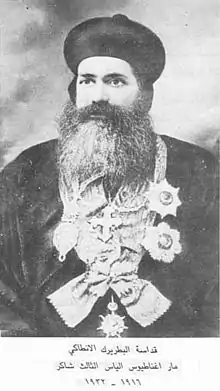
.jpg.webp)
